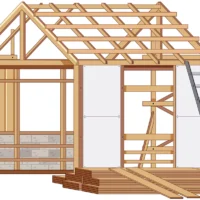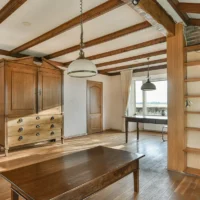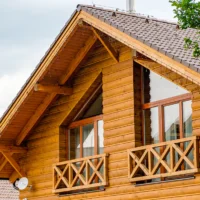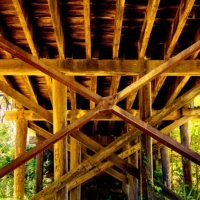Table of Contents
Introduction: Why Choose Interior Log Siding?
When it comes to adding warmth, charm, and rustic appeal to your home, few materials make a statement like interior log siding. Whether you’re building a new log cabin or renovating a single room, interior log siding is a cost-effective and stylish way to bring the outdoors inside—without the structural demands of full log walls.
Homeowners and designers alike love log siding for its natural beauty, cozy ambiance, and ability to match both rustic and modern aesthetics. But it’s not just about looks. Interior log siding offers excellent insulation, enhancing your home’s energy efficiency, especially in colder climates. It’s also more affordable and easier to install than full-log construction, making it a smart option for those seeking the look of a log cabin without the hassle.
In this guide, we’ll cover everything you need to know about interior log siding—from what it is and the types available, to how it compares with exterior siding and what materials work best. Whether you’re planning a full cabin makeover or just accenting a wall, this guide will help you make an informed, stylish, and lasting choice.
What Is Interior Log Siding?
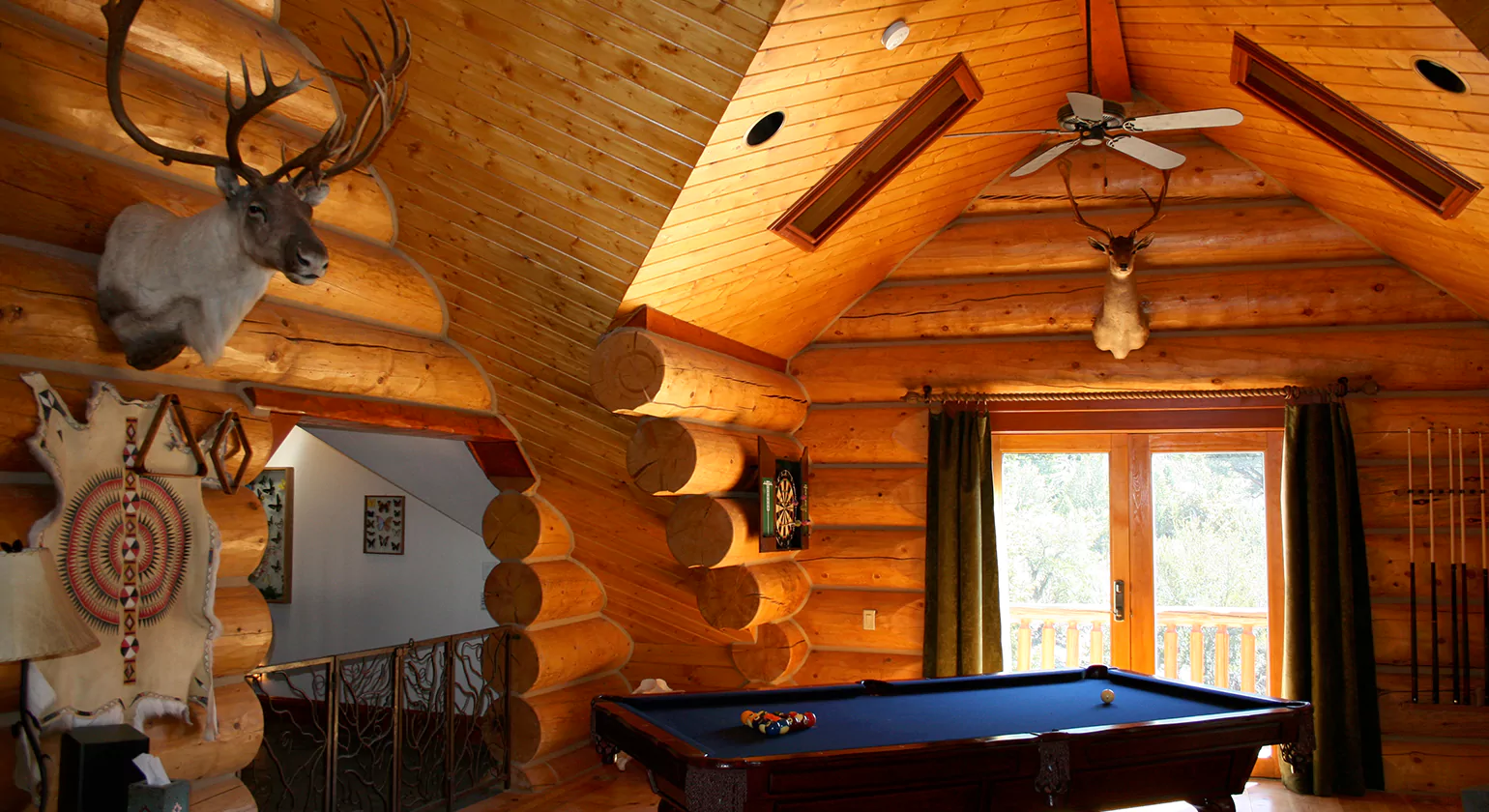
Interior log siding is a type of wood paneling designed to mimic the look of full-log walls but without the weight, cost, or structural requirements. Installed on the inside of your home or cabin, it creates a warm, log-home feel that adds character to any room. Unlike traditional drywall or paneling, log siding brings the texture and visual interest of natural wood into your space.
This siding is typically milled from softwoods like pine, cedar, or spruce and comes in various shapes and profiles. It’s designed to interlock easily, making it ideal for DIYers or professional installations alike. The finish can range from rough-hewn and rustic to smooth and polished, giving homeowners total control over the final look.
Interior vs. Exterior Log Siding
While both types serve aesthetic purposes, they differ in design and durability. Exterior log siding is built to withstand harsh weather conditions, including rain, snow, UV rays, and pests. It usually requires thicker materials and more protective finishes. On the other hand, interior log siding doesn’t face the same exposure, so it’s generally lighter and requires less maintenance. However, it still needs to be sealed and cared for properly to protect against indoor moisture, especially in kitchens and bathrooms.
If you’re after that log cabin vibe without the cost or upkeep of a full log structure, interior log siding is your best bet.
Types of Interior Log Siding

Choosing the right type of interior log siding depends on your aesthetic goals, budget, and level of maintenance you’re willing to commit to. Here are the most popular styles used in homes and cabins:
Tongue and Groove
One of the most common choices for interior log siding, tongue and groove siding features a tongue on one edge and a groove on the other, allowing the boards to fit snugly together. This style creates a clean, tight seam with no visible gaps, making it ideal for a polished, finished look. It’s also great for insulation and noise reduction.
Tongue and groove siding is easy to install and works well both vertically and horizontally. It’s a go-to option for those looking to create a seamless, warm wood finish in any room of the house.
Half-Log Siding
If you’re aiming for an authentic log cabin, feel, half-log siding is your top choice. This siding mimics the appearance of full, rounded logs by using a curved exterior surface and a flat back for easy wall mounting. While it adds more depth and shadowing than tongue and groove, it also takes up slightly more interior space.
Half-log siding is popular in great rooms, living rooms, or any space where you want to make a bold, rustic statement. It pairs especially well with exposed beams and stone fireplaces.
Shiplap Siding
For a more contemporary twist on rustic interiors, shiplap siding is gaining popularity. This style features overlapping boards with a slight gap between them, creating a visually interesting line that adds texture without overpowering the space. Shiplap is often used in modern farmhouses and Scandinavian cabin designs, where simplicity and warmth are key.
Shiplap can be installed horizontally for a traditional look or vertically for a more modern feel. It’s also relatively easy to paint or stain, making it a versatile choice.
Hand-Hewn vs. Smooth Finishes
In addition to choosing the profile, you’ll also want to decide between hand-hewn and smooth finishes. Hand-hewn siding is rough-cut and textured to replicate the look of old-world craftsmanship. It’s ideal for creating that timeworn, vintage cabin aesthetic.
Best Wood Options for Interior Log Siding
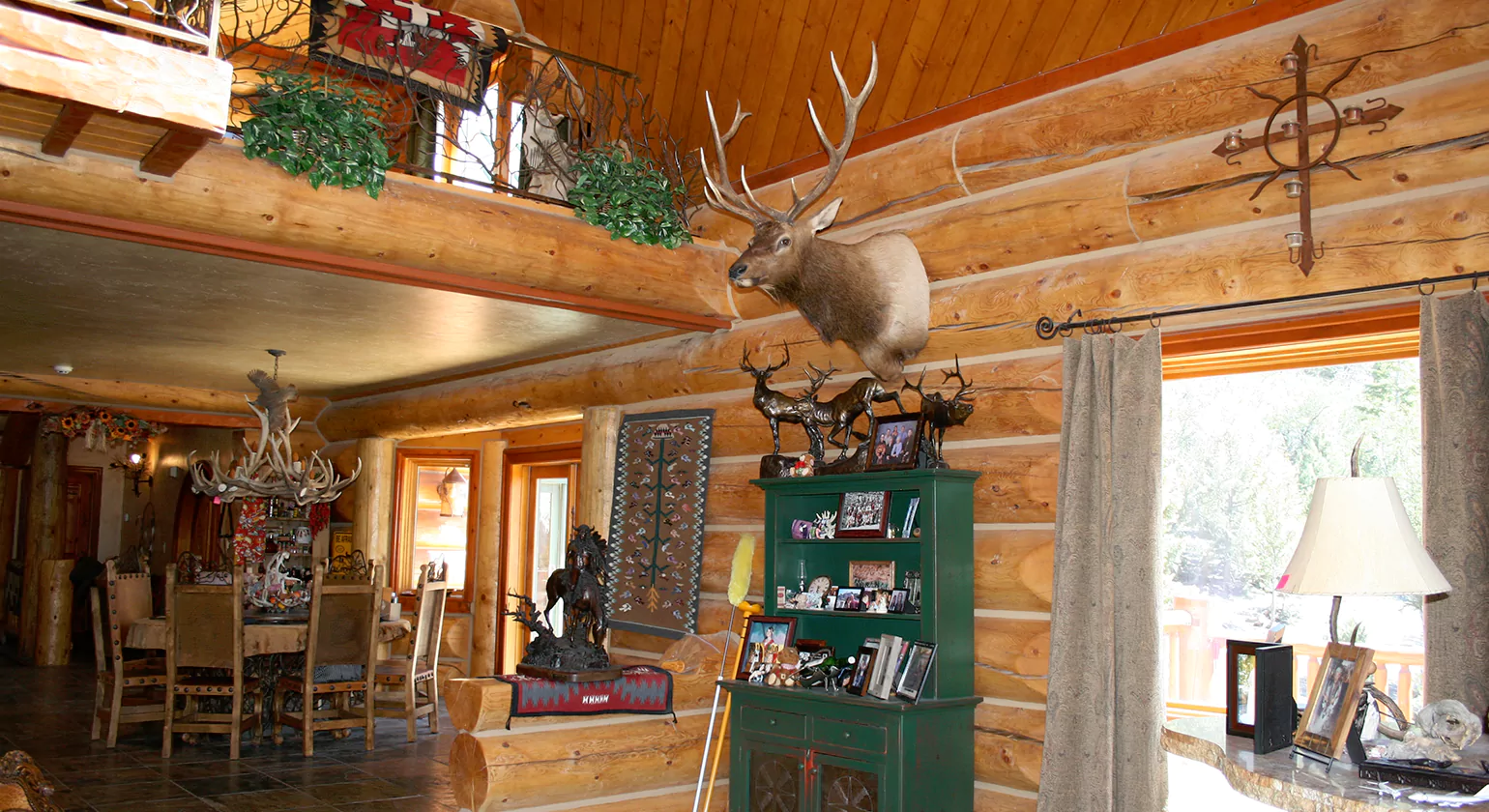
Choosing the right wood for your interior log siding is crucial for both appearance and durability. Different woods offer unique grains, colors, scents, and levels of resistance to moisture or pests. Here are the most popular and practical wood types to consider:
Pine
Pine is one of the most widely used and budget-friendly options for interior log siding. It has a light yellow or creamy color with a subtle grain pattern, making it easy to stain or paint. Pine is soft and easy to work with, which makes it ideal for DIY installations.
Pros:
- Affordable and widely available
- Lightweight and easy to install
- Accepts stain and paint well
- Ideal for smooth or rustic finishes
Cons:
- Softer wood; can dent or scratch more easily
- Less resistant to moisture and insects unless properly sealed
Cedar
Cedar is a premium option, known for its durability and natural resistance to mold, mildew, and insects. It has a rich reddish-brown tone and a pleasant, woodsy aroma that many cabin owners love. Cedar is ideal for areas like bathrooms or kitchens where humidity may be a concern.
Pros:
- Naturally moisture- and pest-resistant
- Distinct aroma and beautiful grain
- Less maintenance required over time
- Long lifespan when properly finished
Cons:
- More expensive than pine or spruce
- Can darken with age if not sealed
Spruce
Spruce is another affordable choice with a light color and subtle grain. It’s slightly harder than pine but still easy to cut and install. Spruce holds paint and stain well and provides a clean, consistent appearance.
Pros:
- Economical and widely available
- Lighter tone for brighter interiors
- Easy to install and maintain
Cons:
- Less resistant to moisture than cedar
- Requires regular sealing in humid areas
Other Options:
- Fir: A durable and moderately priced choice with a straight grain, often used in rustic or craftsman-style homes.
- Cypress: Naturally resistant to decay and insects, but harder to find in some regions.
- Reclaimed Wood: Sustainable and full of character, though more challenging to source and work with.
Design Ideas for Interior Log Siding

Interior log siding isn’t just for log cabins in the woods—it works beautifully in a variety of home styles and settings. Whether you’re creating a cozy retreat or blending rustic charm with contemporary design, here are a few ideas to spark your creativity:
Rustic Cabin Aesthetics
Want the classic log home feel? Covering full walls in tongue and groove pine or half-log cedar instantly gives your room a warm, lived-in charm. Pair it with exposed beams, stone fireplaces, and wrought iron fixtures to complete the look. This style works particularly well in living rooms, dens, or basements were comfort and ambiance matter most.
Blending with Modern or Farmhouse Styles
Interior log siding isn’t limited to all-wood interiors. Use it as a design element alongside modern finishes like white drywall, black metal, or tile flooring for a stunning contrast. In farmhouse-style homes, shiplap or smooth cedar siding adds texture without overwhelming clean lines and light palettes.
Try an accent wall in a bedroom, a backsplash in the kitchen, or ceiling paneling in an entryway to add character without overcommitting.
Feature Walls and Full-Room Designs
Sometimes, a single feature wall is all you need to transform a space. Try a hand-hewn log accent wall behind the bed in your master bedroom or as a backdrop in the dining room. If you’re looking for a bolder look, consider full-room paneling in your home office or reading nook, especially with warm-toned wood like pine or spruce.
Log siding can also be used in creative ways such as:
- Wainscoting with wood on the lower half of the wall
- Ceiling applications to draw the eye upward
- Framed panels for a custom-built-in appearance
How to Install Interior Log Siding
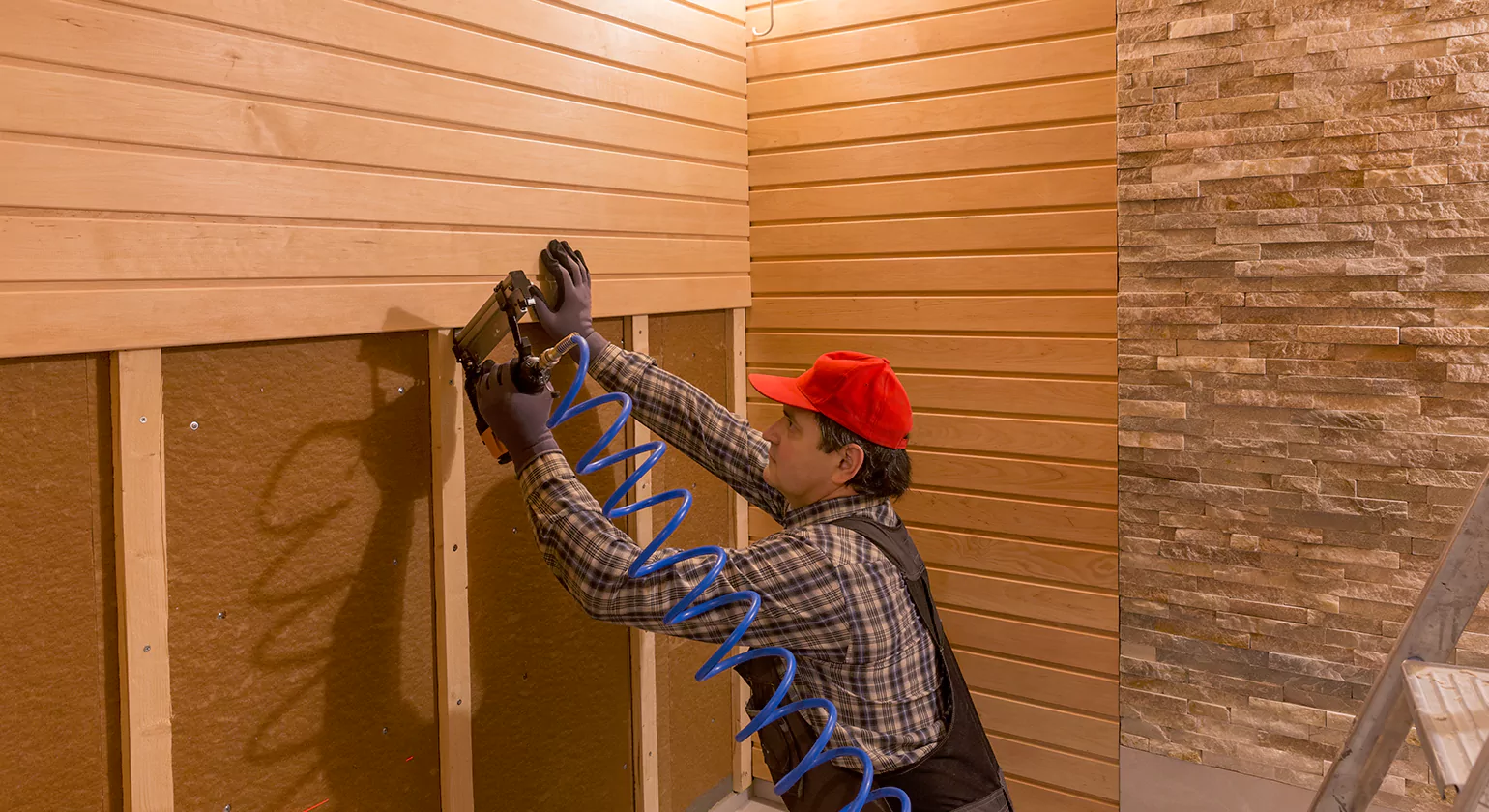
Installing interior log siding is a rewarding DIY project for those with basic carpentry skills. Whether you tackle a single accent wall or an entire room, the process is fairly straightforward. Here’s how to do it right.
Tools You’ll Need
- Measuring tape
- Level
- Circular saw or miter saw
- Nail gun or drill with wood screws
- Stud finder
- Caulk and wood filler
- Wood stain and sealer (optional)
DIY vs. Professional Installation
If you’re handy and have a good set of tools, DIY installation can save you hundreds to thousands of dollars. Interior siding is typically lighter and more forgiving than exterior log materials. However, if you’re covering large areas or dealing with custom cuts and tight spaces, a professional installer may be the better route—especially to ensure seamless alignment and structural safety.
Step-by-Step Process
- Prep the Walls: Remove any baseboards, switch plates, and existing wall coverings. Clean and dry the surface thoroughly.
- Find the Studs: Use a stud finder to locate and mark the wall studs. This ensures the siding is securely anchored.
- Measure and Cut: Measure each siding piece and cut to length using a miter saw. Start from one corner and work your way across.
- Install the First Row: Begin at the bottom of the wall. Use a level to ensure it’s straight. Secure the first piece with nails or wood screws into studs.
- Add Subsequent Rows: For tongue and groove, slide the next board into place and fasten through the tongue at a 45-degree angle. For shiplap or half-log, overlap the edges for a tight fit.
- Finish the Edges: Use trim pieces to frame windows, doors, and corners. Fill any gaps with caulk or wood filler for a polished look.
- Seal and Protect: Apply a clear sealant or stain to protect your siding from moisture, especially in kitchens and bathrooms.
Interior Log Siding vs. Full Log Walls
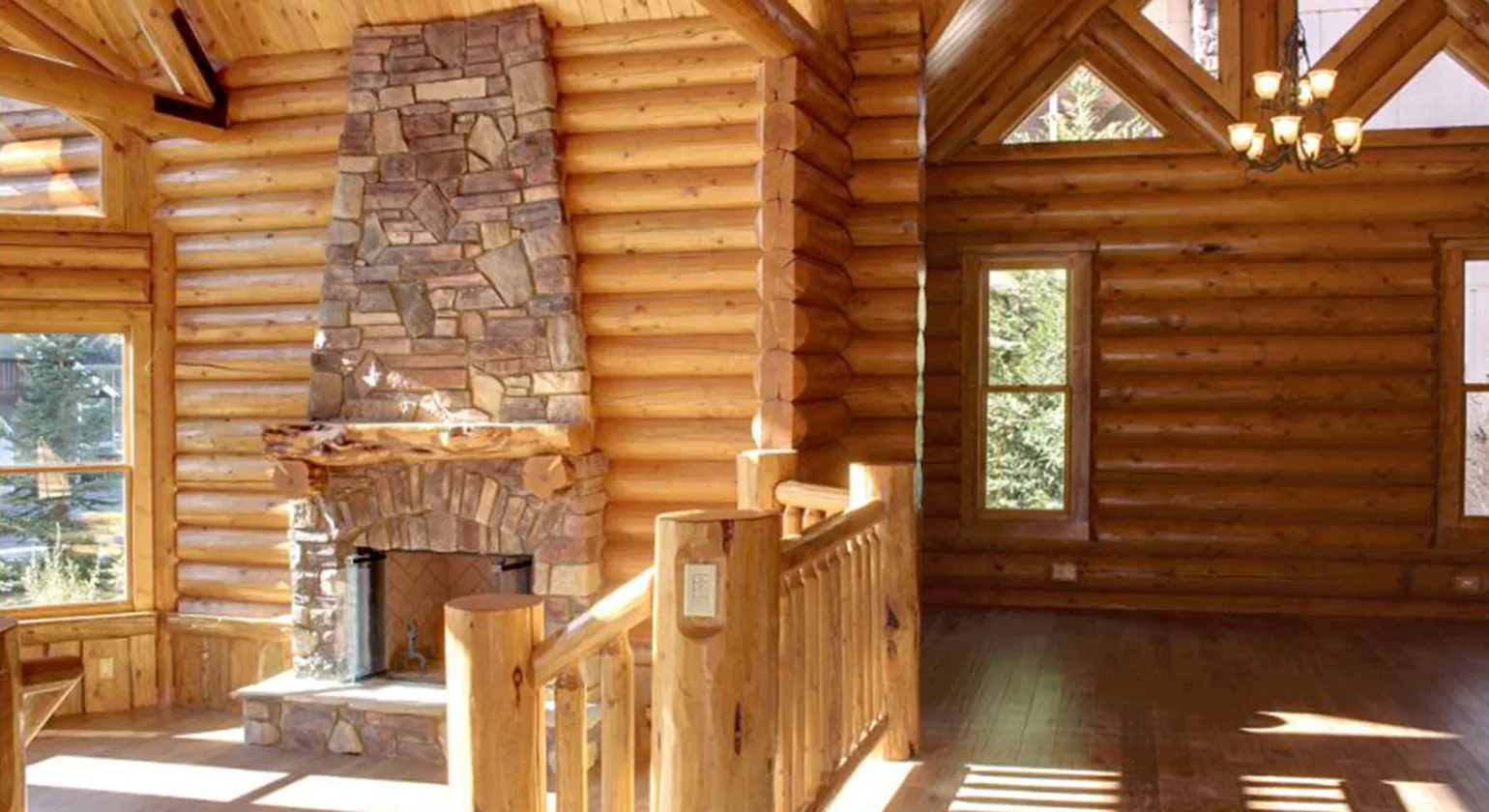
If you love the rustic charm of log homes, you’re likely torn between interior log siding and full log walls. Both provide that iconic woodsy look, but they differ significantly in terms of structure, cost, installation, and maintenance.
Aesthetic and Structural Comparisons
Interior log siding mimics the appearance of full logs but uses only a portion of the wood’s thickness. It can be installed over existing walls, making it a cosmetic upgrade rather than a structural component. The result is nearly identical in terms of appearance—especially when using half-log siding or tongue-and-groove boards.
On the other hand, full log walls are load bearing and part of the home’s frame. They offer unmatched authenticity and historic appeal but come with added weight and design constraints. If you’re building from scratch and want a true log cabin, feel, full log construction is ideal. But for renovations, log siding is far more practical.
Cost, Weight, and Insulation Differences
Cost: Full log walls are more expensive due to the volume of wood, the complexity of construction, and the need for specialized labor. Interior log siding is significantly cheaper, both in material and installation.
Weight: Full logs are heavy and require strong foundational support. In contrast, log siding is much lighter, which means it can be installed on virtually any interior wall.
Insulation: While full logs offer some thermal mass, they don’t always outperform insulated stick-framed walls with log siding. With proper insulation behind the siding, you can achieve excellent energy efficiency—and sometimes better overall performance in modern homes.
Verdict: For most homeowners, interior log siding provides the best balance of beauty, flexibility, and affordability—especially in remodeling projects.
Finishing and Staining Interior Log Siding
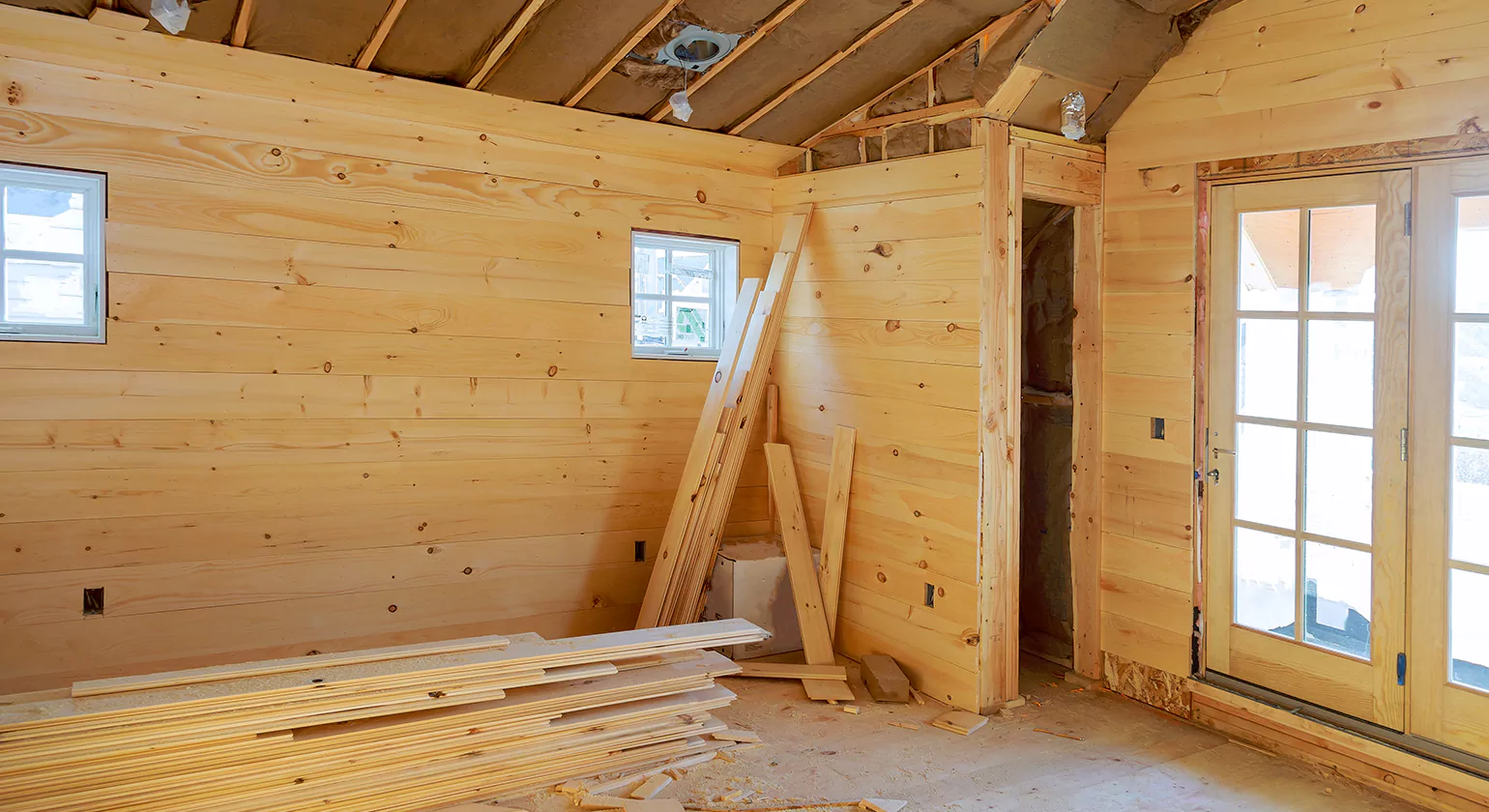
Once your interior log siding is installed, the next step is staining and sealing. This not only enhances the look of the wood but also provides essential protection from moisture, fading, and wear over time.
Prepping for Stain
Before applying any stain or sealant, clean the surface thoroughly. Wipe down the wood with a slightly damp cloth to remove dust and sawdust. If you’re dealing with old or reclaimed wood, light sanding can smooth the surface and open the pores for better absorption.
Let the wood dry completely before staining, and ensure your space is well-ventilated. Use painter’s tape to protect baseboards or trim from overspray or drips.
Best Products for Indoor Wood Protection
For interior applications, choose stains and sealants that are low-VOC and specifically labeled for indoor use. Some popular options include:
- Water-based wood stains: These are eco-friendly, dry quickly, and don’t produce strong fumes—ideal for living spaces.
- Oil-based stains: These penetrate deeper and provide a rich, long-lasting finish but take longer to dry and may have a stronger odor.
- Clear sealants: Use a polyurethane or acrylic topcoat to protect the stained wood from moisture, dust, and scratches.
Look for brands like Minwax, Varathane, or Cabot, which offer excellent indoor wood protection.
Long-Term Maintenance Insights
Over time, even the best finishes can wear down, especially in high-traffic areas or moisture-prone rooms. Plan to reapply a protective coat every 3–5 years, or as needed based on the level of exposure and use.
Avoid high-gloss finishes, which can create unnatural reflections. A satin or matte finish typically works best for maintaining that authentic log look.
Interior Log Siding Maintenance Tips

Maintaining your interior log siding keeps it looking great and extends its lifespan. Fortunately, the interior siding requires less upkeep than exterior logs, but that doesn’t mean it’s maintenance-free.
Cleaning Routines
Regular cleaning is the first step to preserving your log walls. Dust can collect in grooves and corners, while airborne oils from cooking or fireplaces can dull the finish over time.
- Weekly or monthly: Dust the walls using a microfiber cloth or vacuum with a soft brush attachment.
- Seasonally: Wipe down the wood using a mild wood cleaner or oil soap, like Murphy Oil Soap. Avoid harsh chemical cleaners that strip the finish or discolor the wood.
- Annually: Check for signs of fading, moisture stains, or damage. If needed, reapply a light coat of sealant to high-use areas.
Preventing Warping, Mold, and Fading
Even indoors, wood can react to humidity and temperature changes. Use a humidifier or dehumidifier to keep your home’s moisture levels balanced, ideally between 35–50%. Proper climate control prevents issues like cracking, warping, or expansion.
If you notice discoloration or musty smells, inspect for mold or mildew—especially in kitchens, bathrooms, or basements. Treat small spots with a solution of white vinegar and water and improve ventilation in problem areas.
To prevent fading, especially near windows, consider using UV-blocking window film or lightweight curtains to reduce direct sunlight exposure.
When and How to Refinish
Eventually, your siding may require refinishing due to wear or simply for a fresh look. Here’s how:
- Clean and sand the surface lightly to remove dirt and old finish.
- Apply a new stain or color if desired—either to match the original or give it a refreshed style.
- Seal the wood with a protective indoor wood topcoat.
- Let it dry completely before putting furniture or decorations back in place.
Pro tip: Always test new stains or finishes on a small, hidden section first to ensure you love the result.
Cost of Interior Log Siding
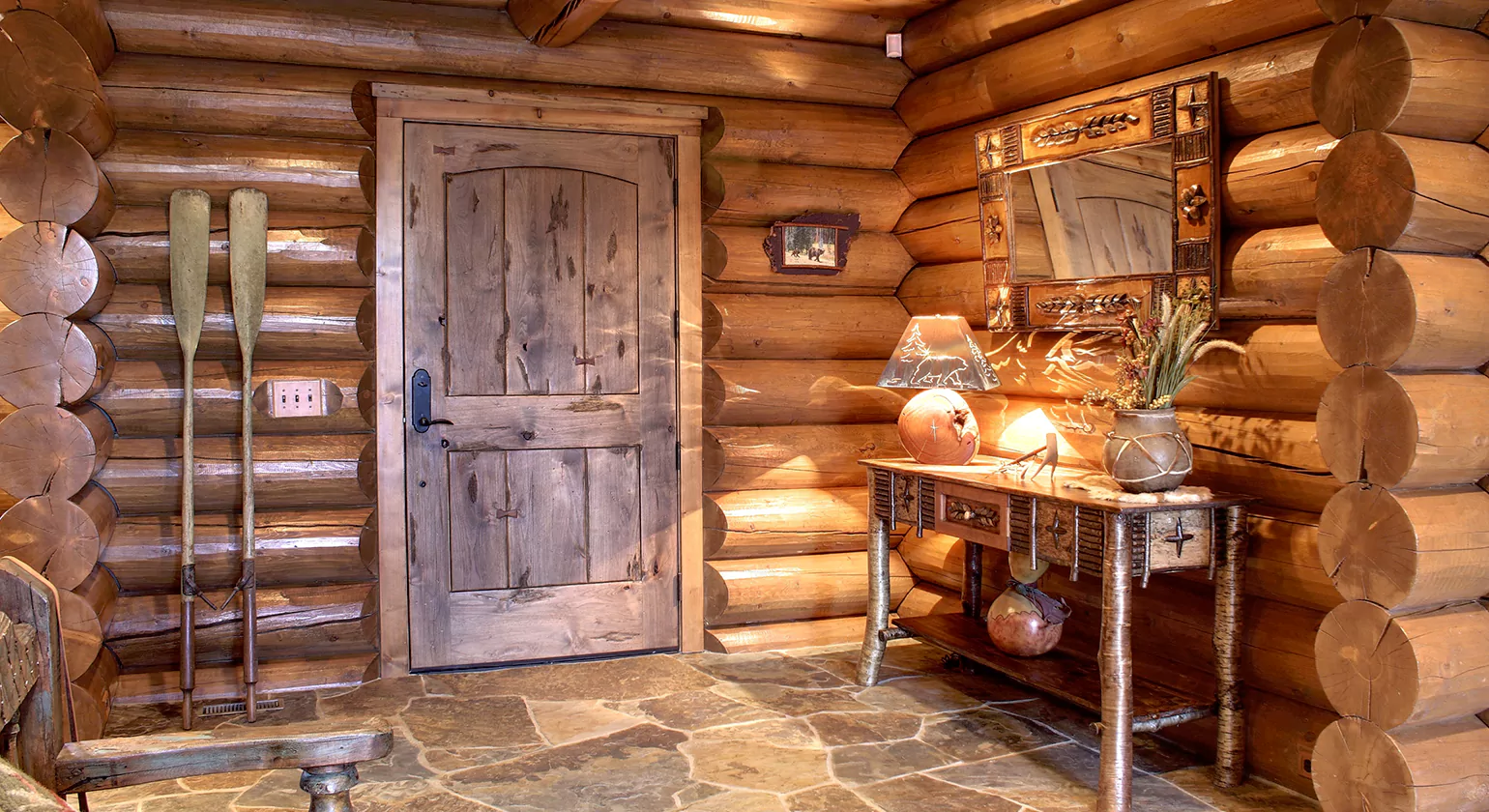
When planning an interior log siding project, cost is a major factor—but it’s not just about price per square foot. Different wood types, finishes, and installation choices all impact the overall budget. Understanding what you’re paying for can help you make informed, cost-effective decisions.
Pricing by Wood Type and Finish
Here’s a breakdown of common interior log siding price ranges by wood type:
- Pine: $2 to $5 per square foot
A budget-friendly choice, especially in tongue-and-groove style. The cost may increase slightly for hand-hewn or custom finishes.
- Spruce: $3 to $6 per square foot
Slightly pricier than pine but often chosen for its uniform appearance and strength.
- Cedar: $5 to $9 per square foot
Cedar commands a premium due to its natural resistance to rot, insects, and moisture.
- Reclaimed Wood: $6 to $12 per square foot
Offers unique character and sustainability, but costs more due to sourcing, preparation, and variations in size or condition.
Finishes also affect price. Pre-finished siding may save time and labor costs, while raw wood is cheaper upfront but requires additional staining and sealing after installation.
Hidden Costs to Consider
Beyond the siding itself, don’t forget to budget for:
- Installation (DIY or professional):
- DIY installation costs mainly include tools and fasteners
- Professional labor ranges from $3 to $6 per square foot
- Underlayment and insulation:
Especially important if you’re improving wall performance in a basement or older home.
- Finishing materials:
Stain, sealant, trim, and fasteners can add $0.50 to $2 per square foot.
- Waste and overage:
Always order 10–15% extra material to account for cuts and errors.
Budgeting for Long-Term Value
While upfront costs matter, interior log siding offers a long-term return on investment through:
- Increased home value and appeal
- Reduced wall maintenance (compared to drywall)
- Enhanced energy efficiency when combined with modern insulation
If you’re looking for rustic aesthetics and durability that lasts for decades, log siding can pay off—especially if installed strategically in focal areas.
Where to Buy Interior Log Siding
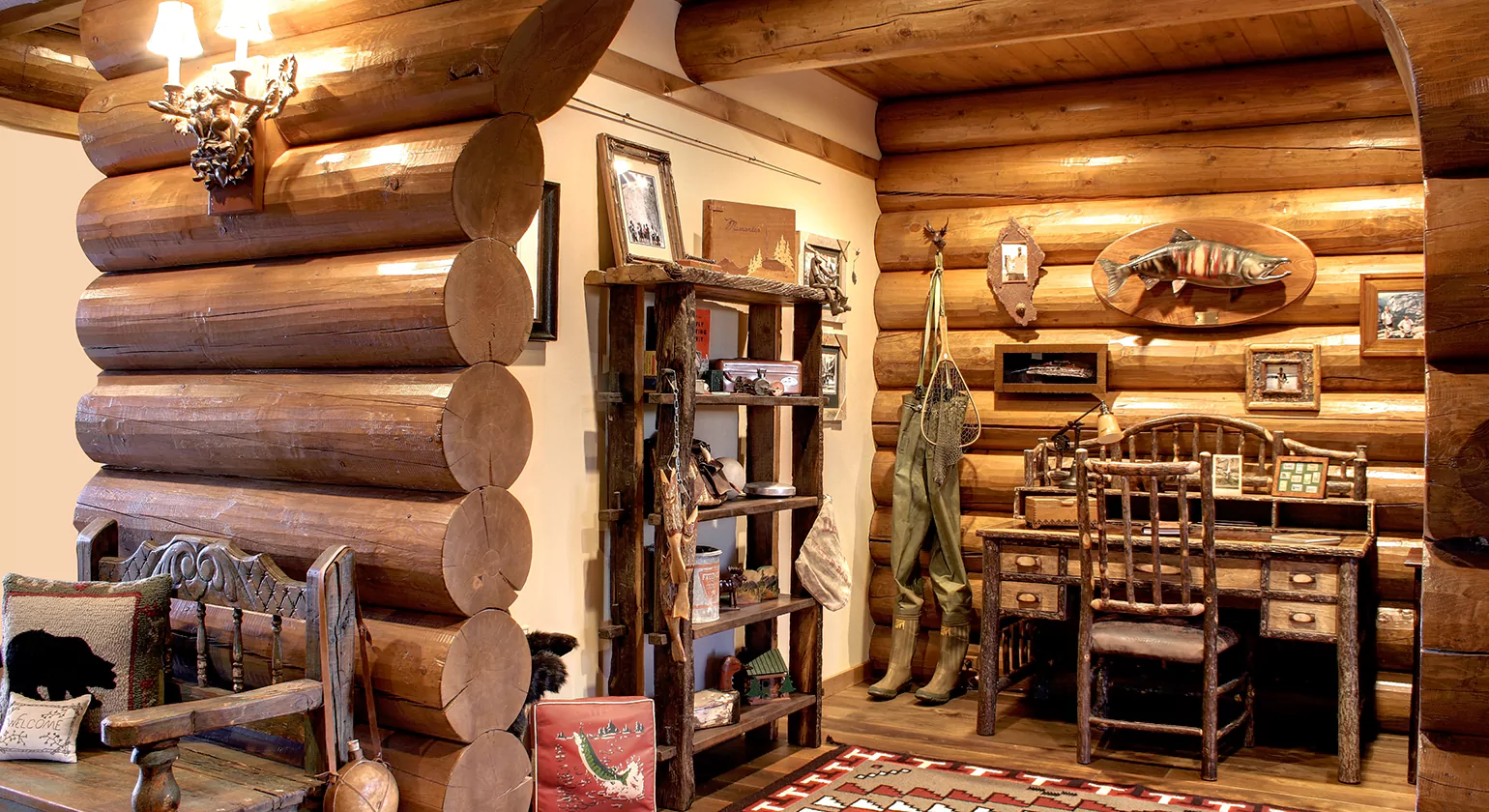
Choosing the right supplier is essential for both quality and peace of mind. Not all log siding is created equal, and working with trusted sources ensures you get consistent products, clear grain, and reliable customer support.
Top Suppliers and Trusted Brands
Here are some reputable options for buying interior log siding:
- WoodHaven Log & Lumber
Offers a wide selection of pre-finished interior log siding, including pine, cedar, and rustic styles.
- Twin Creeks Log Homes
Known for its high-quality half-log siding, shiplap, and tongue-and-groove products in various finishes.
- Hoffmeyer’s Mill (Canada & US)
Specializes in tongue-and-groove log siding and custom trim work.
- Home Depot / Lowe’s
Offer basic pine and spruce log siding in stock or by special order—good for smaller projects or quick turnarounds.
- Etsy & Small Batch Mills
Great for reclaimed wood or custom textures if you’re aiming for a unique, artisan vibe.
What to Look for in Quality Siding
Before purchasing, inspect or inquire about:
- Wood grain and consistency
Uniform grain and minimal knots indicate higher quality.
- Drying process
Kiln-dried wood resists warping, shrinking, and cracking far better than green lumber.
- Milling precision
Ensure the tongue-and-groove or shiplap joints fit tightly with minimal gaps.
- Moisture content
Ideal indoor wood moisture content should be between 6–8% for stability.
Local Lumberyards vs. Online Options
Local lumberyards offer the advantage of in-person inspection and immediate pick-up. They’re especially useful for sourcing wood in specific dimensions or matching existing finishes.
Online retailers provide a broader selection, including pre-finished siding, custom textures, and specialty woods. Make sure to check return policies, shipping fees, and customer reviews before committing to a large order.
Conclusion: Is Interior Log Siding Right for You?
Interior log siding offers the perfect balance between rustic charm and practical design. Whether you’re updating a cabin or adding warmth to a modern home, this siding brings natural beauty, texture, and character into any space. It’s more affordable and easier to install than full log walls, making it a smart choice for homeowners who want the log cabin to feel without the complexity or high cost.
Beyond its aesthetic appeal, interior log siding adds long-term value through durability, insulation benefits, and timeless style. With a wide variety of wood types, finishes, and installation options, you can customize your interior exactly to your taste. If you’re ready to create a cozy, inviting space that reflects nature and craftsmanship, interior log siding is a rewarding and worthwhile investment.
Know more>>> Log Cabin Siding Ideas for a Cozy Timeless Look
FAQ'S
1. What is interior log siding?
Interior log siding is a type of wood paneling that mimics the look of full log walls but is applied to existing interior walls. It’s typically made from real wood—like pine, cedar, or spruce—and comes in styles such as tongue and groove, shiplap, and half-log designs.
2. What are the best types of wood for interior log siding?
The most popular wood choices include pine (affordable and easy to work with), cedar (naturally resistant to moisture and insects), and spruce (strong and smooth). Reclaimed wood is also a stylish and eco-friendly option.
3. How much does interior log siding cost?
Prices typically range from $2 to $9 per square foot, depending on the wood type and finish. Pine is the most budget-friendly, while cedar and reclaimed wood are more expensive. Additional costs include installation, underlayment, stain, and sealants.
4. Is interior log siding better than full log walls?
It depends on your goals. Interior log siding is lighter, more affordable, and easier to install, making it ideal for renovations. Full log walls offer authentic construction but are heavier, more expensive, and less flexible in modern builds.
5. Can I install interior log siding myself?
Yes! Interior log siding is DIY-friendly, especially tongue and groove or shiplap styles. You’ll need tools like a level, nail gun, saw, and measuring tape. However, for large projects or custom work, hiring a professional may save time and ensure a perfect finish.
6. How do I finish and stain interior log siding?
After cleaning the surface, apply a low-VOC wood stain suitable for indoor use, followed by a protective sealant like polyurethane. Water-based options are eco-friendlier and faster-drying, while oil-based stains offer deeper color and durability.
7. How do I maintain interior log siding?
Clean the walls regularly with a microfiber cloth or wood-safe cleaner. Prevent moisture buildup with proper ventilation and use a humidifier or dehumidifier to regulate indoor climate. Reapply stain or sealant every few years, depending on wear.
8. Where can I buy high-quality interior log siding?
Trusted suppliers include WoodHaven Log & Lumber, Twin Creeks Log Homes, and Hoffmeyer’s Mill. You can also find log siding at Home Depot, Lowe’s, and specialty online retailers. Always check for kiln-dried wood, consistent grain, and reliable shipping.
9. Does interior log siding add value to a home?
Yes, it enhances both aesthetic appeal and resale value. Its timeless look and insulating properties make it a desirable feature for homebuyers, especially in cabins, mountain homes, or rustic-modern interiors.



